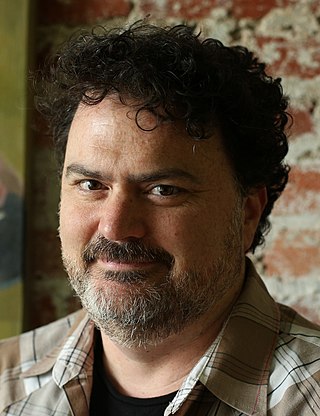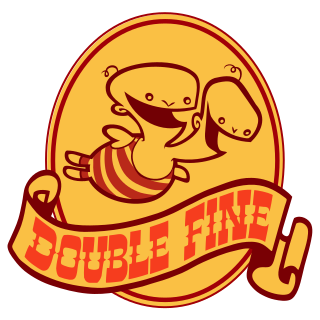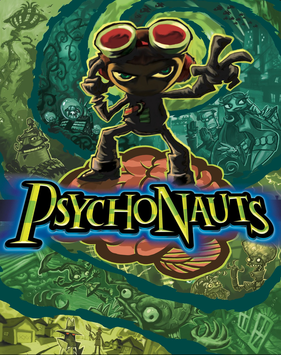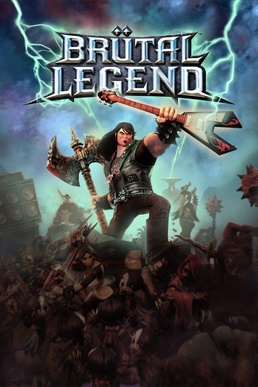
Timothy John Schafer is an American video game designer. He founded Double Fine Productions in July 2000, after having spent over a decade at LucasArts. Schafer is best known as the designer of critically acclaimed games Full Throttle, Grim Fandango, Psychonauts, Brütal Legend and Broken Age, co-designer of Day of the Tentacle, and assistant designer on The Secret of Monkey Island and Monkey Island 2: LeChuck's Revenge. He is well known in the video game industry for his storytelling and comedic writing style, and has been given both a Lifetime Achievement Award from the Game Developers Choice Awards, and a BAFTA Fellowship for his contributions to the industry.

Double Fine Productions, Inc. is an American first-party video game developer of Xbox Game Studios based in San Francisco, California. Founded in July 2000 by Tim Schafer shortly after his departure from LucasArts, Double Fine's first two games – Psychonauts and Brütal Legend – underperformed publishers' expectations despite critical praise. The future of the company was assured when Schafer turned to several in-house prototypes built during a two-week period known as "Amnesia Fortnight" to expand as smaller titles, all of which were licensed through publishers and met with commercial success. Schafer has since repeated these Amnesia Fortnights, using fan-voting mechanics, to help select and build smaller titles. Double Fine is also credited with driving interest in crowdfunding in video games, having been able to raise more than US$3 million for the development of Broken Age, at the time one of the largest projects funded by Kickstarter, and more than US$3 million for the development of Psychonauts 2.

Psychonauts is a 2005 platform game developed by Double Fine Productions and published by Majesco Entertainment for Microsoft Windows, Xbox and PlayStation 2.

Ada Wong is a character in Resident Evil, a survival horror video game series created by the Japanese company Capcom. Ada was first mentioned in the original Resident Evil (1996), before being introduced as a supporting character and antiheroine in Resident Evil 2 (1998). The character was initially conceived as a researcher named Linda for the prototype of the second game, but her name was changed to Ada and she was rewritten as a spy and mercenary for the final build to connect its story to that of the original. Over the course of the series, Ada is often hired to steal biological weapons for various organizations, although she betrays her employers on numerous occasions to save protagonist Leon S. Kennedy from dire situations.

G-man is an American slang term for agents of the United States Government. It is especially used as a term for an agent of the Federal Bureau of Investigation (FBI).

Erik Wolpaw is an American video game writer. He and Chet Faliszek wrote the pioneering video game website Old Man Murray. He subsequently worked for game developers Double Fine Productions and Valve, and is known for his work on video games including Half-Life 2, Psychonauts, Portal, Portal 2 and Half-Life: Alyx.

The Minus World is a glitched level found in the 1985 video game Super Mario Bros. It can be encountered by maneuvering the protagonist, Mario, in a particular way to trick the game into sending him to the wrong area. Players who enter this area are greeted with an endless, looping water level in the original Nintendo Entertainment System cartridge version, while the version released for the Famicom Disk System sends them to a sequence of three different levels; this difference is due to the data being arranged in different ways between the two versions. It gained exposure in part thanks to the magazine Nintendo Power discussing how the glitch is encountered. Super Mario Bros. creator Shigeru Miyamoto denied that the addition of the Minus World was intentional, though he later commented that the fact that it does not crash the game could make it count as a game feature.

Brütal Legend is an action-adventure video game with real-time strategy game elements created by Double Fine and published by Electronic Arts for the PlayStation 3 and Xbox 360. The game was released during October 2009 in North America, Europe, and Australia. Though Brütal Legend was originally to be published by Vivendi Games prior to its merger with Activision, Activision dropped the game from its portfolio after the merger. It was later picked up by Electronic Arts, though Activision and Double Fine brought counter-lawsuits against each other over publishing issues. The issues were settled out of court. Later, Double Fine announced a port of the game for Microsoft Windows via Steam, which was released in February 2013. Mac OS X and Linux versions of the game were made available as part of the Humble Bundle in May 2013. A physical collector's edition for Windows, Mac OS X, and Linux was released by IndieBox in October 2014.

The Room Tribute is a point-and-click adventure game released on September 3, 2010, that serves as an unofficial adaptation of the 2003 film The Room directed by Tommy Wiseau. It was programmed by Newgrounds founder Tom Fulp, with artwork by Newgrounds staff member Jeff "JohnnyUtah" Bandelin, and music by animator Chris "OneyNG" O'Neill. The game was designed in the style of 16-bit graphics, much like similar games based on the films Tremors and The Hunger Games for Newgrounds' own 2010 and 2012 April Fools jokes.
Old Man Murray (OMM) is a UGO Networks computer game commentary and reviews site, known for its highly irreverent and satiric tone. Founded in 1997, it was written and edited by Chet Faliszek and Erik Wolpaw. Old Man Murray was critical of games that received strong reviews elsewhere, Common targets of OMM news updates included John Romero and American McGee. Old Man Murray was a significant early influence in both the world of game development and internet comedy, and is often considered to have "helped birth online games journalism".

Psychonauts 2 is a 2021 platform game developed by Double Fine and published by Xbox Game Studios. The game was announced at The Game Awards 2015 ceremony, and released on August 25, 2021 for PlayStation 4, Windows, Xbox One and Xbox Series X/S, and on May 24, 2022 for Linux and macOS.
Klint Honeychurch is an American graphic designer, video game designer, programmer, and writer. He designed Double Fine's free Adobe Flash games: the graphic adventure Host Master and the Conquest of Humor, sports game parody My Game About Me: Olympic Challenge, puzzle-platform game Tasha's Game, and fighting game Epic Saga: Extreme Fighter.
Nathan Stapley is an American artist. He was the lead artist on Double Fine's adventure game Broken Age and has worked on Psychonauts and Psychonauts 2.
Razmig Mavlian is an Armenian-Canadian artist, animator, video game developer, and musician. His nickname "Raz" was the inspiration for the name of the main character in Psychonauts. He currently is a concept artist at Oculus VR.
Brad Muir is an American computer game designer and programmer. He was a designer on Brütal Legend, and the project leader of Iron Brigade, Brazen, and Massive Chalice.

Jazzpunk is an adventure video game developed by Necrophone Games and published by Adult Swim Games. The game was released for Microsoft Windows, OS X and Linux in February 2014. A director's cut of the game, self-published by Necrophone Games, was released for the PlayStation 4 in September 2016, and for personal computer platforms in June 2017.

Fig was a crowdfunding platform for video games. It launched in August 2015. Unlike traditional crowdfunding approaches like Kickstarter, where individuals can back a project to receive rewards, Fig used a mixed model that includes individual backing and the opportunity for uncredited investors to invest as to obtain a share of future revenues for successful projects. At the end of 2017, four projects had begun generating returns, returning 245% to Fig investors.

Psychonauts in the Rhombus of Ruin is a virtual reality adventure game developed and published by Double Fine Productions. It was released for the PlayStation 4 through PlayStation VR in February 2017 and on Microsoft Windows in April 2018. The game's story bridges the events between Psychonauts and Psychonauts 2.

Daniel John Hardcastle, known online as Nerd³ or NerdCubed, is a British YouTuber, author and actor. Created in 2011, his YouTube channel primarily consists of video game-related content. As of September 2023, it has approximately 2.44 million subscribers and 1.34 billion video views. He is the author of The Sunday Times bestseller Fuck Yeah, Video Games: The Life and Extra Lives of a Professional Nerd.

Dracula's Castle is the main setting of the video game Castlevania: Symphony of the Night (1997), which was designed by Koji Igarashi. Players control the protagonist Alucard as they explore the castle, which was based on the traditional depiction of Castle Dracula from the horror novel by Bram Stoker and related media, and is one of numerous incarnations in the Castlevania series. Upon defeating Shaft, a minion of Dracula, players are able to enter the Inverted Castle, an upside down version of the original castle that was included because the designers wanted to add more content without having to create new assets. The Inverted Castle served as inspiration for multiple games, such as 2014's Strider and Igarashi's Bloodstained: Ritual of the Night.

















